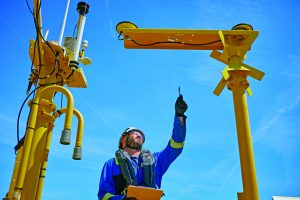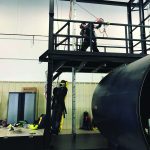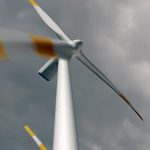Over the 20 to 25 year design life of a wind turbine, usually only the first two are covered under warranty. As the end of the warranty period approaches, it’s common practice to give the turbine a thorough inspection, identify problems, and have the OEM repair them. The maintenance on most complex equipment can be described in a typical bathtub-shaped curve. Maintenance activity usually falls throughout the manufacturer’s warranty period, levels off in the post-warranty period — during which the owner pays for repairs — and climbs again late in the equipment service life.
The table Damage Statistics, shows the failure causes on about 1,000 turbines from 11 different manufacturers. Look closely and you’ll spot trends in failure locations. These locations should be checked prior to warranty expiration. Ideally, the inspection is ideally performed several months before warranty expiration. Table 1
Statistically, one in ten turbines faced relevant damage each year of those remotely monitored. Costs for a planned repair are on average less than 30 percent of replacing a component. The bottom line is that consequential damages can be prevented. (Source: DEWI).]]
Statistically, every 10th turbine faced a relevant damaging event every year. Costs for a planned repair are on average less than 30 percent compared to the replacement of a component. (Source: DEWI). Consequential damages can be prevented.
So what should be monitored as the inspection approaches, and what is the best method for effective condition monitoring? Consider a few options for a typical MW-class wind turbine.
Main Bearing
The repair of the main bearing typically involves removing the hub. With vibration analysis condition monitoring, the lead times are often quite long, on the order of several months. This is largely in part to the slow speed and intermittent operation. Grease analysis is one method to determine the condition of the bearing condition. Other conditions (such as imbalance for example) cannot be detected with grease analysis. So with arguably one of the most expensive repairs on a turbine, end of warranty inspection needs to be addressed.
Gearbox
The accompanying table shows common inspection techniques for a wind turbine gearbox. There is a significant difference between which worn components can be detected with a bore scope and a vibration-analysis inspection. A bore scope doesn’t address the main bearing, generator, or correctable conditions such as misalignment, imbalance, looseness, generator lubrication, and electrical shorting. Despite these gaps in detection, it is still considered the standard practice for end-of-warranty inspections. Table 2
Repairs in the planetary section and low-speed shaft (LSS) usually require a crane call-out. Repairs in intermediate and high speed shafts (HSS) of some models can be performed up-tower for a fraction of the downtime and crane cost. Oil analysis also can help, especially when the testing looks for a proper moisture content, total acid number, viscosity, and particle counts.
“You get a full picture of the condition of a drivetrain using a bore scope and vibration together,” says Upwind Solutions Director of Quality Control Russell Leach. “They complement each other to give a 360 degree view of the gearbox health.”
Generators
Not much is done on a generator in typical end-of-warranty inspections. Hence, it’s a good idea to use vibration analysis. “Vibration analysis makes detecting major failure modes in the generator a piece of cake,” says Don Roberts of B9 energy. “Resistance testing usually requires manufacturers’ approval beforehand.” Table 3
The best methods for ensuring that a turbine will enter post warranty in good shape give the manufacturer and owner a clear and thorough picture of the turbine’s condition. “The renewable energy tax credit is paid when the turbines are reliable and productive,” says Roberts.
“To ensure reliability, install a permanent condition-monitoring system within 12 to 18 months prior to the end of warranty. This enables “alarming,” and a sufficient data stream to support claims and maximize the value of a condition-based monitoring system,” adds Roberts.





































